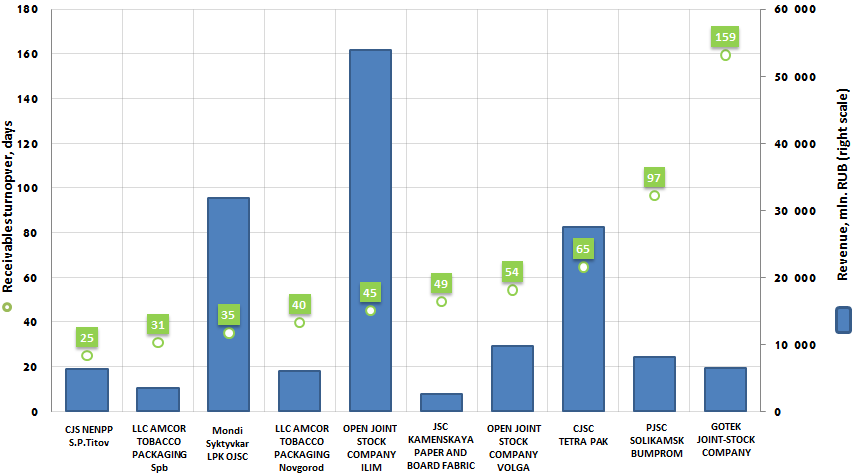Receivables turnover of paper and cardboard manufacturers
Information agency Credinform prepared a ranking of companies in the RF engaged in paper and cardboard manufacturing.
Companies with the highest volume of revenue were selected for this ranking according to the data from the Statistical Register for the latest available period (for the year 2013). The enterprises were ranked by increase in receivables turnover.
Receivables turnover is short- and long-term receivables for the period to sales revenue. It shows the average number of days required for debt recovery. The less is the number, the faster receivables turns to the monetary funds; therefore liquidity of working capital increases.
The ratio shows the efficiency of resources usage by taking the time factor into account.
For the most comprehensive and fair view on the company’s financial condition it is necessary to pay attention not only to the average values in the industry, but also to the whole presented set of financial indicators and ratios.
| № | Name | Region | Revenue, mln. RUB, 2013 | Receivables turnover, days | Solvency index GLOBAS-i® |
|---|---|---|---|---|---|
| 1 | CJS National Enterprise Naberezhnochelninsky paperboard plant S.P.Titov INN 1650017638 |
the Republic of Tatarstan | 6 256 | 25 | 181 the highest |
| 2 | LIMITED LIABILITY COMPANY AMCOR TOBACCO PACKAGING SAINT PETERSBURG INN 7842315276 |
Saint-Petersburg | 3 524 | 31 | 195 the highest |
| 3 | Mondi Syktyvkar LPK OJSC INN 1121003135 |
the Republic of Komi | 31 818 | 35 | 241 high |
| 4 | LIMITED LIABILITY COMPANY AMCOR TOBACCO PACKAGING NOVGOROD INN 5321070760 |
the Novgorod region | 6 004 | 40 | 206 high |
| 5 | OPEN JOINT-STOCK COMPANY ILIM GROUP INN 7840346335 |
Saint-Petersburg | 53 940 | 45 | 294 high |
| 6 | JOINT STOCK COMPANY KAMENSKAYA PAPER AND BOARD FABRIC INN 6929000141 |
the Tver region | 2 623 | 49 | 247 high |
| 7 | OPEN JOINT STOCK COMPANY VOLGA INN 5244009279 |
the Nizhniy Novgorod region | 9 736 | 54 | 281 high |
| 8 | CLOSED JOINT STOCK COMPANY TETRA PAK INN 7706017070 |
Moscow | 27 513 | 65 | 213 high |
| 9 | PUBLIC JOINT STOCK COMPANY SOLIKAMSKBUMPROM INN 5919470121 |
the Perm Territory | 8 146 | 97 | 237 high |
| 10 | GOTEK JOINT-STOCK COMPANY INN 4633000037 |
the Kursk region | 6 416 | 159 | 289 high |

Picture 1. Receivables turnover and revenue of the largest paper and cardboard manufacturers (top-10)
On the potential for use of standard charters by legal entities
As known, the quality of governance is one of the key factors of the successful development of the economy. The priorities of lawmaking in this direction are to limit the influence of the state in the economic sphere, as well as to reduce administrative barriers for business.
The Russian civil legislation, being in the constant development, continues to make tracks in the direction of reducing of the excessive state regulation. Namely in this direction the Federal Law from 29.06.2015 №209-FZ "On making of amendments to certain legislative acts of the Russian Federation regarding the introduction of the potential for use of standard charters by legal entities" was adopted and signed by the President of the Russian Federation on the 29th of June 2015.
The law changes a number of positions of the first chapter of the Civil Code of the Russian Federation and the Federal laws, which relate to the articles of association of legal entities.
It is possible to summarize 25 amendments to the above mentioned legal documents as follows:
- standard charter does not provide the data on names, deployment and sizes of the authorized capital of legal entities. The obligation to approve it by founders (participants) of companies falls down, and this function will be assigned to the authorized state body;
- notifications about the operation on the basis of the standard charter are to be sent to the authority of state registration of legal entities (in the present time - to the Federal Tax Service of the RF and its local subdivisions) with relevant reflection of this in the Unified state register of legal entities (EGRUL). That is, there will be no need to send the charter to a registering authority, both in electronic and paper form;
- for limited liability companies it will be retained the right to continue working under individual charters, executed in paper form. Therefore, two types of charters are provided for legal persons: a standard one adopted by the authorized government body and an individual one approved by company’s founders (participants).
The law in whole enters into force from the 29th of December 2015, and on individual items – from the 1st of January 2016. Up to this moment it must be clarified the public bodies, being authorized to approve the standard charters, and the forms of standard charters.
According to experts, such innovations can help reduce the time of registration of legal entities and the costs associated with it, both on the part of entrepreneurs and the state; simplify the procedure of drawing up and legal implementation of charter; reduce the efforts for verifying of the charter documents on the part of contractors. Looking forward, it will certainly have a positive impact on the development of business in general and small business in particular.